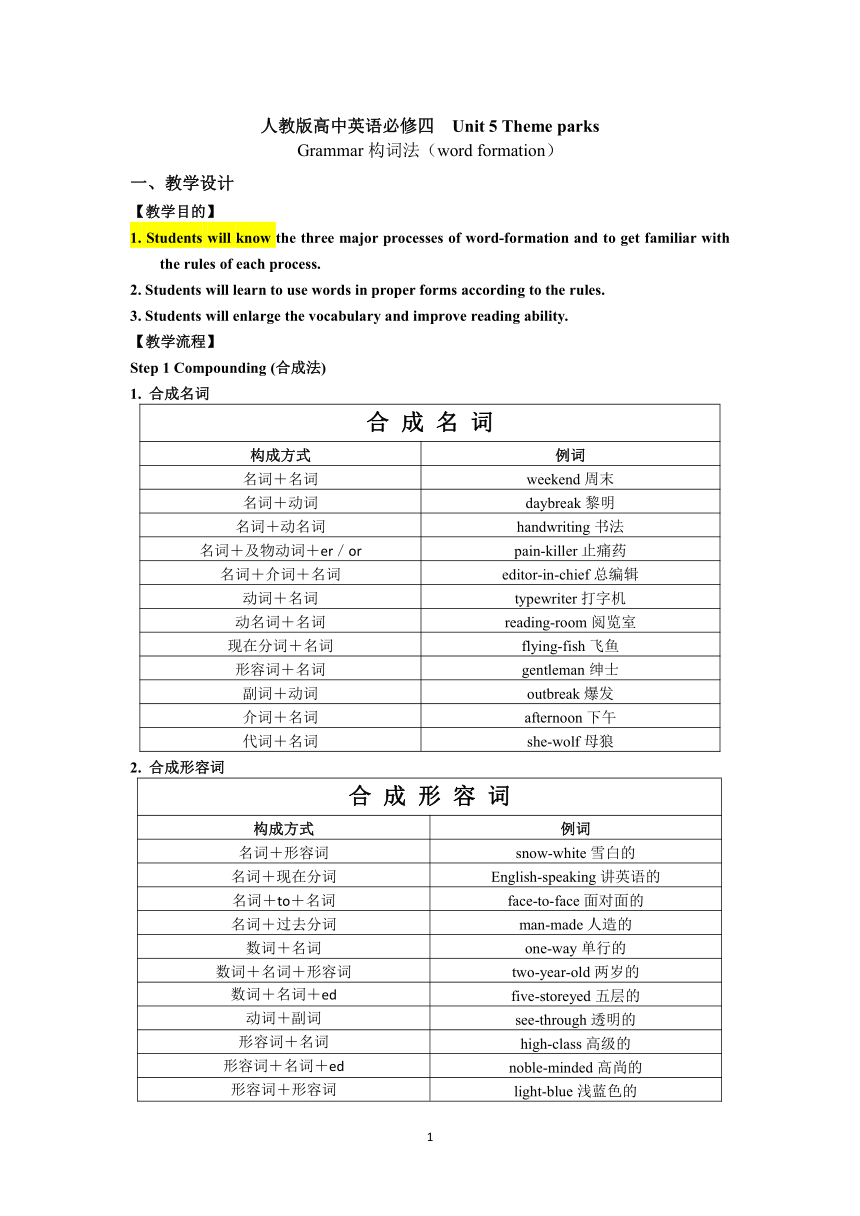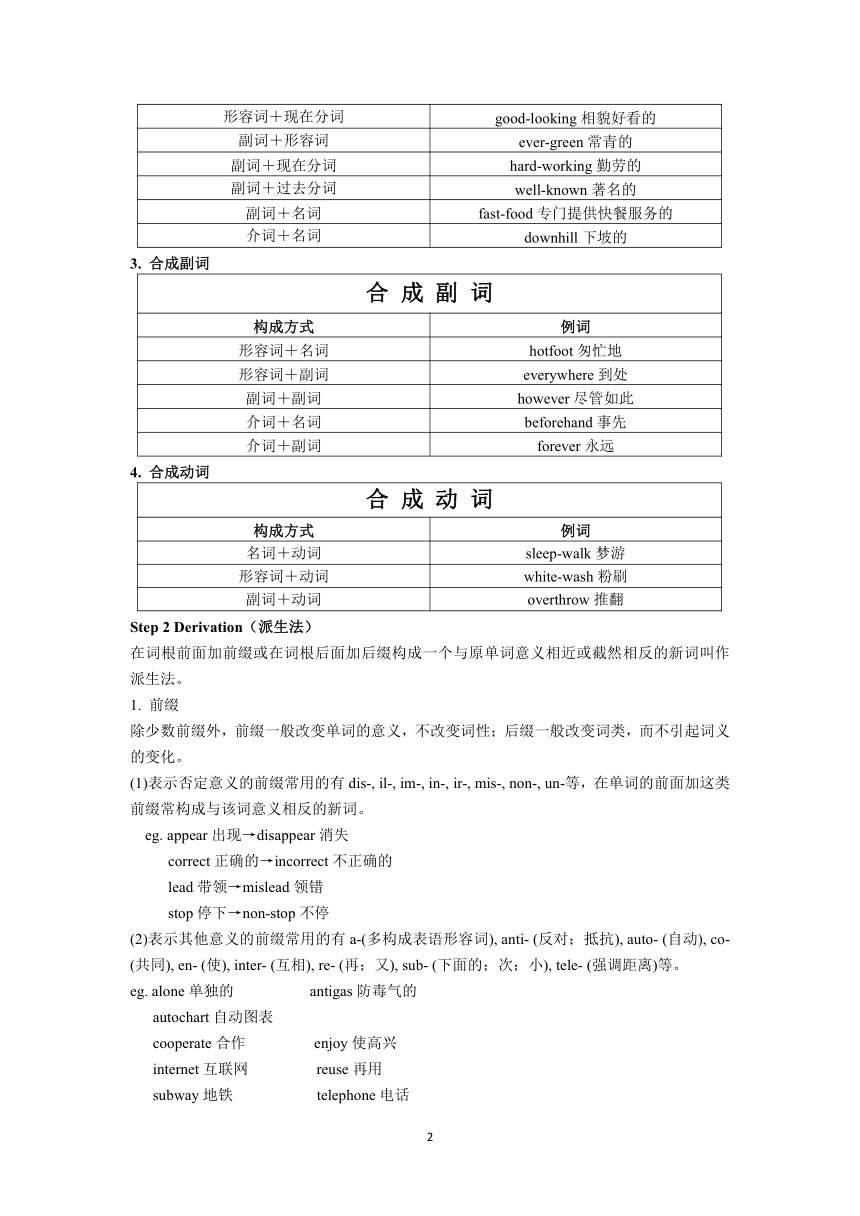人教版(新课程标准)必修四 Unit 5 Theme parks构词法教学设计
文档属性
| 名称 | 人教版(新课程标准)必修四 Unit 5 Theme parks构词法教学设计 |  | |
| 格式 | doc | ||
| 文件大小 | 86.9KB | ||
| 资源类型 | 教案 | ||
| 版本资源 | 人教版(新课程标准) | ||
| 科目 | 英语 | ||
| 更新时间 | 2021-11-14 22:05:01 | ||
图片预览


文档简介
人教版高中英语必修四 Unit 5 Theme parks
Grammar构词法(word formation)
一、教学设计
【教学目的】
1. Students will know the three major processes of word-formation and to get familiar with the rules of each process.
2. Students will learn to use words in proper forms according to the rules.
3. Students will enlarge the vocabulary and improve reading ability.
【教学流程】
Step 1 Compounding (合成法)
合成名词
合 成 名 词
构成方式 例词
名词+名词 weekend周末
名词+动词 daybreak黎明
名词+动名词 handwriting书法
名词+及物动词+er/or pain-killer止痛药
名词+介词+名词 editor-in-chief总编辑
动词+名词 typewriter打字机
动名词+名词 reading-room阅览室
现在分词+名词 flying-fish飞鱼
形容词+名词 gentleman绅士
副词+动词 outbreak爆发
介词+名词 afternoon下午
代词+名词 she-wolf母狼
合成形容词
合 成 形 容 词
构成方式 例词
名词+形容词 snow-white雪白的
名词+现在分词 English-speaking讲英语的
名词+to+名词 face-to-face面对面的
名词+过去分词 man-made人造的
数词+名词 one-way单行的
数词+名词+形容词 two-year-old两岁的
数词+名词+ed five-storeyed五层的
动词+副词 see-through透明的
形容词+名词 high-class高级的
形容词+名词+ed noble-minded高尚的
形容词+形容词 light-blue浅蓝色的
形容词+现在分词 good-looking相貌好看的
副词+形容词 ever-green常青的
副词+现在分词 hard-working勤劳的
副词+过去分词 well-known著名的
副词+名词 fast-food专门提供快餐服务的
介词+名词 downhill下坡的
合成副词
合 成 副 词
构成方式 例词
形容词+名词 hotfoot匆忙地
形容词+副词 everywhere到处
副词+副词 however尽管如此
介词+名词 beforehand事先
介词+副词 forever永远
合成动词
合 成 动 词
构成方式 例词
名词+动词 sleep-walk梦游
形容词+动词 white-wash粉刷
副词+动词 overthrow推翻
Step 2 Derivation(派生法)
在词根前面加前缀或在词根后面加后缀构成一个与原单词意义相近或截然相反的新词叫作派生法。
1. 前缀
除少数前缀外,前缀一般改变单词的意义,不改变词性;后缀一般改变词类,而不引起词义的变化。
表示否定意义的前缀常用的有dis-, il-, im-, in-, ir-, mis-, non-, un-等,在单词的前面加这类前缀常构成与该词意义相反的新词。
eg. appear出现→disappear消失
correct正确的→incorrect不正确的
lead带领→mislead领错
stop停下→non-stop不停
表示其他意义的前缀常用的有a-(多构成表语形容词), anti- (反对;抵抗), auto- (自动), co- (共同), en- (使), inter- (互相), re- (再;又), sub- (下面的;次;小), tele- (强调距离)等。
eg. alone单独的 antigas防毒气的
autochart自动图表
cooperate合作 enjoy使高兴
internet互联网 reuse再用
subway地铁 telephone电话
2. 后缀
英语单词不仅可以通过加前缀构成新词,也可加后缀构成新词。后缀通常会改变单词的词性,构成意义相近的其他词性;少数后缀还会改变词义,变为与原来词义相反的新词。
(1)构成名词的后缀常用的有-ence,-(e)r/ -or (从事某事的人),-ese (某地人),-ess (雌性),-ful (一……),-ian (精通……的人),-ist (专业人员),-ment (性质;状态),-ness (性质;状态),-tion(动作;过程)等。
eg. differ不同于→difference区别
write写→writer作家
Japan日本→Japanese日本人
act表演→actress女演员
mouth口→mouthful一口
music音乐→musician音乐家
构成动词的后缀常用的有-(e)n (多用于形容词之后),-fy (使……化),-ize (使……成为)。
eg. wide→widen加宽
beauty→beautify美化
pure→purify提纯
real→realize意识到
organ→organize组织
(3)构成形容词的后缀常用的有-al,-able (有能力的),-(a)n(某国人的),-en (多用于表示材料的名词后),-ern (方向的),-ese(某国人的),-ful,-(ic)al,-ish,-ive,-less (表示否定),-like (像……的),-ly,-ous,-some,-y (表示天气)等。
eg. nature自然→natural自然的
reason道理→reasonable有道理的
America美国→American美国的
China中国→Chinese中国人的
gold金子→golden金的
east东→eastern东方的
child孩子→childish孩子气的
snow雪→snowy雪的
(4)构成副词的常用后缀有-ly (主要用于形容词之后表示方式或程度),-ward(s) (主要用于表示方位的词之后表示方向)。
eg. angry生气的→angrily生气地
to到→towards朝……,向……
east东方→eastward向东
(5)构成数词的后缀有-teen (十几),-ty (几十),-th (构成序数词)。
eg. six六→sixteen十六→sixteenth第十六
four四→forty四十→fortieth第四十
Step 3 Conversion(转化法)
英语中,有的名词可作动词,有的形容词可作副词或动词,这种把一种词性用作另一种词性而词形不变的方法叫作转化法。
1)动词转化为名词
很多动词可以转化为名词,大多数情况下,意思没有多大的变化,
eg. Let’s go out for a walk.
有时意思有一定变化,
eg. He is a man of strong build.
有的与一个动词和不定冠词构成短语,表示一个动作,
eg. Let’s have a swim.
2)名词转化为动词
很多表示物件,
eg. Did you book a seat on the plane
身体部位,
eg. Please hand me the book.
某类人的名词可以用作动词来表示动作,
eg. She nursed her husband back to health.
某些抽象名词也可作动词。
eg. We lunched together.
3)形容词转化为动词
有少数形容词可以转化为动词。
eg. We will try our best to better our living conditions.
4)副词转化为动词
有少数副词可以转化为动词。
eg. Murder will out.(谚语)恶事终必将败露。
5)形容词转化为名词
表示颜色的形容词常可转化为名词,
eg. You should be dressed in black at the funeral.你在葬礼中该穿黑色衣服
某些形容词如old, young, poor, rich, wounded, injured等与the连用,表示一类人,作主语时,谓语用复数如下,
eg. The old in our village are living a happy life.我们村的老年人过着幸福的生活。
即学即练:
1. In the chart below, combine the words from the first two columns to make compound words in the third column.
Column 1 Column 2 Compound words
butter worn down northfoot earthhard mobileice mankind headlap easylife homewater passerworth egg phone ballline creamout flygoing heartedeastern melonland sizedby topkind townquake whileplant working butterfly worn-out downtown northeastern football earthquake hardworking mobilephone icecream mankind kindhearted headline laptop easy-going life-sized homeland watermelon passer-by worthwhile eggplant
New words can also be formed by using prefixes and suffixes. Find and underline the prefixes and suffixes in the words below. Then write out the original words.
unchangeable adj. change
unfriendly adj. friend
athletic adj. athlete
dislike v. like
overwork v. work
misread v. read
impossibility n. possible
misunderstanding n. understand
translator n. translate
Step 3 Summary
The structure of the period is:
Step 4 Homework
构词法(Word formation)
合成法(Compounding)
派生法(Derivation)
转化法(Conversion)
Grammar构词法(word formation)
一、教学设计
【教学目的】
1. Students will know the three major processes of word-formation and to get familiar with the rules of each process.
2. Students will learn to use words in proper forms according to the rules.
3. Students will enlarge the vocabulary and improve reading ability.
【教学流程】
Step 1 Compounding (合成法)
合成名词
合 成 名 词
构成方式 例词
名词+名词 weekend周末
名词+动词 daybreak黎明
名词+动名词 handwriting书法
名词+及物动词+er/or pain-killer止痛药
名词+介词+名词 editor-in-chief总编辑
动词+名词 typewriter打字机
动名词+名词 reading-room阅览室
现在分词+名词 flying-fish飞鱼
形容词+名词 gentleman绅士
副词+动词 outbreak爆发
介词+名词 afternoon下午
代词+名词 she-wolf母狼
合成形容词
合 成 形 容 词
构成方式 例词
名词+形容词 snow-white雪白的
名词+现在分词 English-speaking讲英语的
名词+to+名词 face-to-face面对面的
名词+过去分词 man-made人造的
数词+名词 one-way单行的
数词+名词+形容词 two-year-old两岁的
数词+名词+ed five-storeyed五层的
动词+副词 see-through透明的
形容词+名词 high-class高级的
形容词+名词+ed noble-minded高尚的
形容词+形容词 light-blue浅蓝色的
形容词+现在分词 good-looking相貌好看的
副词+形容词 ever-green常青的
副词+现在分词 hard-working勤劳的
副词+过去分词 well-known著名的
副词+名词 fast-food专门提供快餐服务的
介词+名词 downhill下坡的
合成副词
合 成 副 词
构成方式 例词
形容词+名词 hotfoot匆忙地
形容词+副词 everywhere到处
副词+副词 however尽管如此
介词+名词 beforehand事先
介词+副词 forever永远
合成动词
合 成 动 词
构成方式 例词
名词+动词 sleep-walk梦游
形容词+动词 white-wash粉刷
副词+动词 overthrow推翻
Step 2 Derivation(派生法)
在词根前面加前缀或在词根后面加后缀构成一个与原单词意义相近或截然相反的新词叫作派生法。
1. 前缀
除少数前缀外,前缀一般改变单词的意义,不改变词性;后缀一般改变词类,而不引起词义的变化。
表示否定意义的前缀常用的有dis-, il-, im-, in-, ir-, mis-, non-, un-等,在单词的前面加这类前缀常构成与该词意义相反的新词。
eg. appear出现→disappear消失
correct正确的→incorrect不正确的
lead带领→mislead领错
stop停下→non-stop不停
表示其他意义的前缀常用的有a-(多构成表语形容词), anti- (反对;抵抗), auto- (自动), co- (共同), en- (使), inter- (互相), re- (再;又), sub- (下面的;次;小), tele- (强调距离)等。
eg. alone单独的 antigas防毒气的
autochart自动图表
cooperate合作 enjoy使高兴
internet互联网 reuse再用
subway地铁 telephone电话
2. 后缀
英语单词不仅可以通过加前缀构成新词,也可加后缀构成新词。后缀通常会改变单词的词性,构成意义相近的其他词性;少数后缀还会改变词义,变为与原来词义相反的新词。
(1)构成名词的后缀常用的有-ence,-(e)r/ -or (从事某事的人),-ese (某地人),-ess (雌性),-ful (一……),-ian (精通……的人),-ist (专业人员),-ment (性质;状态),-ness (性质;状态),-tion(动作;过程)等。
eg. differ不同于→difference区别
write写→writer作家
Japan日本→Japanese日本人
act表演→actress女演员
mouth口→mouthful一口
music音乐→musician音乐家
构成动词的后缀常用的有-(e)n (多用于形容词之后),-fy (使……化),-ize (使……成为)。
eg. wide→widen加宽
beauty→beautify美化
pure→purify提纯
real→realize意识到
organ→organize组织
(3)构成形容词的后缀常用的有-al,-able (有能力的),-(a)n(某国人的),-en (多用于表示材料的名词后),-ern (方向的),-ese(某国人的),-ful,-(ic)al,-ish,-ive,-less (表示否定),-like (像……的),-ly,-ous,-some,-y (表示天气)等。
eg. nature自然→natural自然的
reason道理→reasonable有道理的
America美国→American美国的
China中国→Chinese中国人的
gold金子→golden金的
east东→eastern东方的
child孩子→childish孩子气的
snow雪→snowy雪的
(4)构成副词的常用后缀有-ly (主要用于形容词之后表示方式或程度),-ward(s) (主要用于表示方位的词之后表示方向)。
eg. angry生气的→angrily生气地
to到→towards朝……,向……
east东方→eastward向东
(5)构成数词的后缀有-teen (十几),-ty (几十),-th (构成序数词)。
eg. six六→sixteen十六→sixteenth第十六
four四→forty四十→fortieth第四十
Step 3 Conversion(转化法)
英语中,有的名词可作动词,有的形容词可作副词或动词,这种把一种词性用作另一种词性而词形不变的方法叫作转化法。
1)动词转化为名词
很多动词可以转化为名词,大多数情况下,意思没有多大的变化,
eg. Let’s go out for a walk.
有时意思有一定变化,
eg. He is a man of strong build.
有的与一个动词和不定冠词构成短语,表示一个动作,
eg. Let’s have a swim.
2)名词转化为动词
很多表示物件,
eg. Did you book a seat on the plane
身体部位,
eg. Please hand me the book.
某类人的名词可以用作动词来表示动作,
eg. She nursed her husband back to health.
某些抽象名词也可作动词。
eg. We lunched together.
3)形容词转化为动词
有少数形容词可以转化为动词。
eg. We will try our best to better our living conditions.
4)副词转化为动词
有少数副词可以转化为动词。
eg. Murder will out.(谚语)恶事终必将败露。
5)形容词转化为名词
表示颜色的形容词常可转化为名词,
eg. You should be dressed in black at the funeral.你在葬礼中该穿黑色衣服
某些形容词如old, young, poor, rich, wounded, injured等与the连用,表示一类人,作主语时,谓语用复数如下,
eg. The old in our village are living a happy life.我们村的老年人过着幸福的生活。
即学即练:
1. In the chart below, combine the words from the first two columns to make compound words in the third column.
Column 1 Column 2 Compound words
butter worn down northfoot earthhard mobileice mankind headlap easylife homewater passerworth egg phone ballline creamout flygoing heartedeastern melonland sizedby topkind townquake whileplant working butterfly worn-out downtown northeastern football earthquake hardworking mobilephone icecream mankind kindhearted headline laptop easy-going life-sized homeland watermelon passer-by worthwhile eggplant
New words can also be formed by using prefixes and suffixes. Find and underline the prefixes and suffixes in the words below. Then write out the original words.
unchangeable adj. change
unfriendly adj. friend
athletic adj. athlete
dislike v. like
overwork v. work
misread v. read
impossibility n. possible
misunderstanding n. understand
translator n. translate
Step 3 Summary
The structure of the period is:
Step 4 Homework
构词法(Word formation)
合成法(Compounding)
派生法(Derivation)
转化法(Conversion)
同课章节目录
